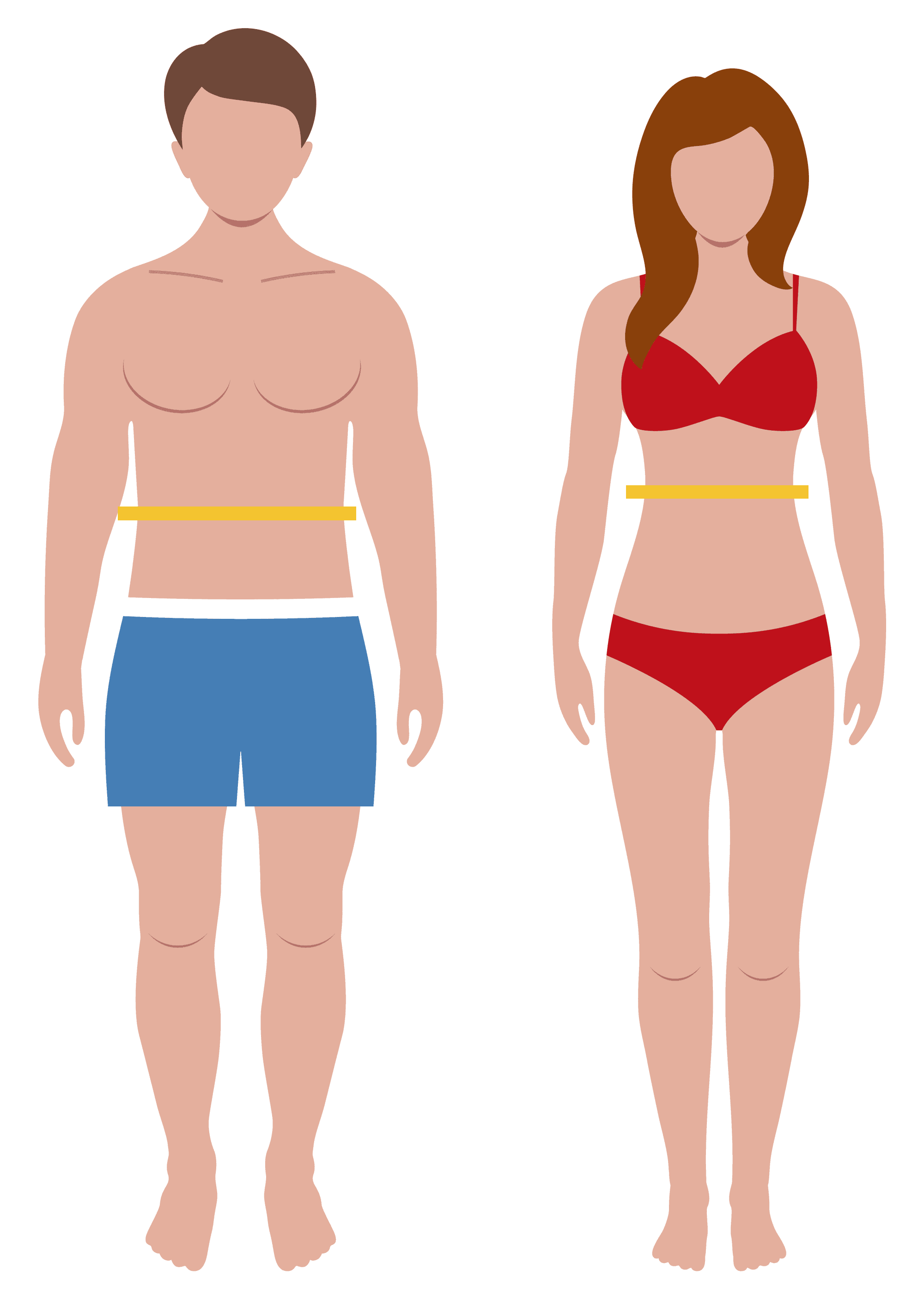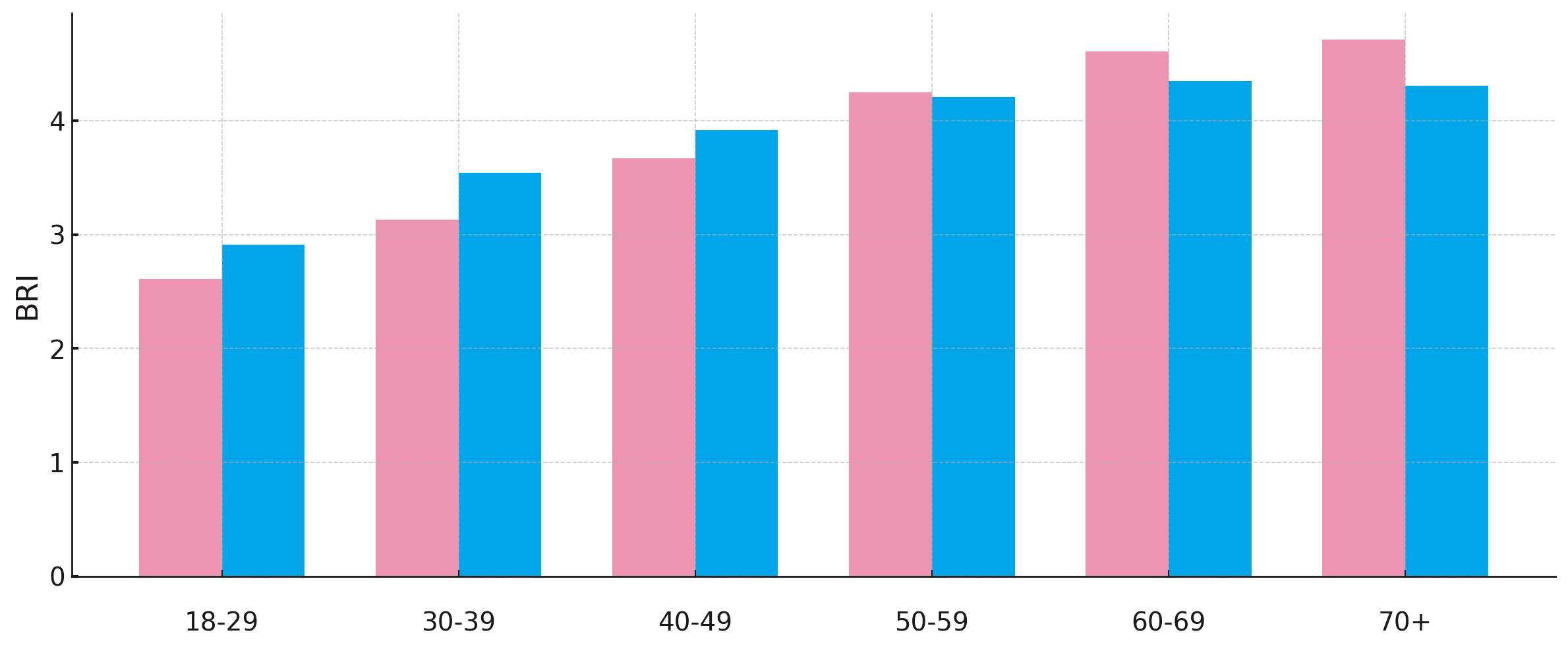BRI Calculator Body Roundness Index
Our free BRI calculator helps females and males get a more accurate health check! By including belly fat, assessing heart risk, and being ideal for those with muscle, our online BRI calculator offers a better alternative to BMI.
Curious? Enter your details and discover your Body Roundness Index now.
Average BRI Results Through This Website
- Average BRI in total: 4.01 (Lean to average body shape)
- Average BRI for women: 3.73 (Lean to average body shape)
- Average BRI for men: 4.30 (Lean to average body shape)
How to Use the BRI Calculator
- Pick a measurement unit and enter your height and waist circumference.
- Optional: fill in your hip circumference, weight, gender, and age to see extra results like your waist-to-hip ratio (WHR), BMI, body fat percentage, visceral fat mass, and fat tissue (VAT).
- Click "Calculate my BRI" to see your BRI result.
How Do I Measure My Waist?
It's best to measure in the morning, before breakfast, in light clothing or without a shirt for a consistent measurement

- Stand up straight with your feet together and breathe out gently.
- Find your natural waist: it’s the narrowest part of your torso, between your ribs and hips.
- Wrap a measuring tape around your waist horizontally. No measuring tape? Use a string, mark where the ends meet, and measure the length with a ruler.
- Measure your waist after a gentle exhale, without sucking in or pushing out your belly.
Calculate your BRI
Why BRI Might Be More Reliable Than BMI
- BRI takes waist circumference into account, which is a key indicator of belly fat.
- It responds better to variations in body shape and fat distribution.
- It might be more suitable for predicting heart disease risks.
- It provides a more accurate picture for people with a lot of muscle mass.
Newest Blogs About BRI

Understanding Your BRI Results
Our free BRI calculator gives you a BRI value and an explanation based on recent studies:
- BRI under 3.41: Very slim body shape (lowest 20% of the population). This indicates a relatively narrow waist and a very slim build.
- BRI between 3.41 and 4.45: Slim to average body shape (lower 20-40% of the population). This suggests your body shape is slim to average, with a waist circumference smaller than most people’s.
- BRI between 4.45 and 5.46: Average body shape (middle 40-60% of the population). This indicates an average build, with no significant slimness or roundness.
- BRI between 5.46 and 6.91: Above average body roundness (upper 60-80% of the population). This means you have an above average body shape, with a larger waist circumference than most people.
- BRI of 6.91 or higher: High body roundness (top 20% of the population). This suggests a high body roundness shape, which might come with an increased health risk.
Keep in mind that BRI only measures one aspect of your health. For a complete picture, it’s smart to check in with a doctor. They can consider other factors like nutrition, physical activity, genetics, and overall health in their assessment.
Average BRI by Gender and Age
This is based on the study "Body Roundness Index and Mortality Among Adults in the U.S." (Zhang et al.), which looked at the link between body shape, fat distribution, and health risks across different age and gender groups in the American population.

Average BRI for Women
| Age Group | Average BRI | BRI Range |
|---|---|---|
| 18-29 years | 2.61 | 1.72 - 3.50 |
| 30-39 years | 3.13 | 2.01 - 4.25 |
| 40-49 years | 3.67 | 2.37 - 4.97 |
| 50-59 years | 4.25 | 2.85 - 5.65 |
| 60-69 years | 4.61 | 3.15 - 6.07 |
| 70+ years | 4.71 | 3.20 - 6.22 |
Average BRI for Men
| Age Group | Average BRI | BRI Range |
|---|---|---|
| 18-29 years | 2.91 | 1.93 - 3.89 |
| 30-39 years | 3.54 | 2.42 - 4.66 |
| 40-49 years | 3.92 | 2.74 - 5.10 |
| 50-59 years | 4.21 | 2.98 - 5.44 |
| 60-69 years | 4.35 | 3.10 - 5.60 |
| 70+ years | 4.31 | 3.04 - 5.58 |
These averages give you a handy way to compare your BRI with others in the same age and gender group. But keep in mind that health is influenced by a lot of factors, so these numbers should really just be seen as a rough guideline.
Calculate your BRI
Frequently Asked Questions
What is the Body Roundness Index (BRI)?
The Body Roundness Index (BRI) is a measure that assesses body shape and fat distribution by taking into account height, weight, and waist circumference. It is considered a more accurate indicator of health risks compared to the traditional Body Mass Index (BMI).
Read more: What Exactly Is the Body Roundness Index (BRI)?
How is BRI calculated?
BRI is calculated using a mathematical formula that utilizes both waist circumference and height. This allows for an estimation of a person's body fat percentage and body shape.
Read more: How to Calculate Your BRI?

Why is waist circumference important for measuring health?
Waist circumference is a significant indicator of abdominal fat, which is associated with an increased risk of chronic diseases such as cardiovascular diseases, type 2 diabetes, and metabolic syndrome. Measuring waist circumference provides a better understanding of fat distribution than just weight or BMI alone.
How often should I measure my BRI?
It is recommended to measure your BRI periodically, for example, every 3-6 months, especially if you are making lifestyle changes such as starting a new diet or exercise program. This helps you monitor your progress and make adjustments as needed.
What is a healthy BRI value?
A healthy BRI value varies depending on age and gender. Generally, BRI values between 4 and 5 are considered average, while values above 6 indicate increased body roundness and possibly higher health risks.
Read more:
How accurate is BRI compared to other methods?
BRI is more accurate in assessing abdominal fat and body shape than BMI, as it considers waist circumference. However, other methods, such as DEXA scans, can be even more accurate but are often less accessible and more expensive.
Read more: How Reliable Is the BRI?
Is BRI suitable for all ages?
While BRI can be useful for adults, it is not always suitable for children and teenagers, as their bodies change during growth. Specific guidelines and methods are needed to assess health and body fat for these groups.
Read more: How Your Body Fat Changes with Age and What You Can Do About It
How does BRI relate to health risks?
A higher BRI can indicate more abdominal fat, which is often associated with an increased risk of conditions such as type 2 diabetes, cardiovascular diseases, and high blood pressure. It is therefore a useful indicator for assessing these risks.
Can BRI predict health problems?
Although BRI is not a diagnostic tool, it can help identify increased risks for health problems such as cardiovascular diseases and type 2 diabetes. It is a useful tool for early detection of potential risks.
Why should I use BRI instead of BMI?
You might want to use BRI instead of BMI if you want a better understanding of your body shape and fat distribution, especially if you have a high muscle mass, as BMI does not account for these factors.
Read more: BRI vs. BMI: What’s the Best Way to Measure Your Health?
How can I improve my BRI?
You can improve your BRI through regular exercise, a healthy diet, and reducing abdominal fat. This not only improves your BRI value but also lowers health risks. Strength training can help maintain muscle mass, which is important for maintaining a healthy body fat percentage. Additionally, avoiding high-sugar and high-carb foods can help reduce abdominal fat, directly impacting your BRI.
Can I lower my BRI directly by losing weight?
Yes, losing weight can directly lower your BRI, especially if the weight loss comes primarily from abdominal fat. Reducing your waist circumference has a greater impact on your BRI than just losing body weight in general. It is important to focus on a combination of healthy eating, aerobic exercises, and strength training to effectively reduce both your weight and waist circumference. Changes in your BRI are likely to be more noticeable if you specifically lose abdominal fat.
Read more: How to Lower Your BRI: Practical Tips to Reduce Belly Fat
Are there limitations to using BRI?
Yes, BRI does not account for muscle mass, bone density, and other factors that also play a role in health. People with high muscle mass may have a higher BRI without actually having a high body fat percentage.
How does muscle mass affect BRI value?
People with high muscle mass may have a higher BRI value without it indicating an unhealthy body fat percentage. BRI primarily measures abdominal fat and body roundness but cannot differentiate between muscle mass and fat mass.
Is BRI suitable for athletes and bodybuilders?
For athletes and bodybuilders, BRI can be misleading as it does not differentiate between muscle mass and fat mass. For this group, an alternative method such as body fat percentage calculation or a DEXA scan is more suitable.
Is BRI suitable for people with medical conditions?
For people with certain medical conditions, such as obesity, underweight, or certain hormonal disorders, BRI may not be the most suitable measure. In such cases, it is advisable to consult a doctor for a more comprehensive assessment.
Can pregnant women use BRI?
BRI is not suitable for pregnant women, as waist circumference changes significantly during pregnancy, making calculations inaccurate.
What role does genetics play in BRI?
Genetics can influence where and how much fat the body stores, which can affect your BRI value. Some people may naturally have a higher or lower BRI regardless of their diet or physical activity.
What is the difference between BRI and WHR (Waist-to-Hip Ratio)?
BRI assesses body shape based on waist circumference and height, while WHR measures the ratio between waist and hip circumference. Both methods can provide insights into fat distribution and health risks, but BRI offers a broader view of body shape.
Calculate your BRI
More Information About BRI
- How Your Body Fat Changes with Age and What You Can Do About It
- How to Lower Your BRI: Practical Tips to Reduce Belly Fat
- BRI vs. BMI: What’s the Best Way to Measure Your Health?
- What Exactly Is the Body Roundness Index (BRI)?
- How Reliable Is the BRI?
- How to Calculate Your BRI?
- What is the Perfect BRI for Men?
- What is the Perfect BRI for Women?
- What is a Healthy BRI by Age?
- Afrikaans
- Azərbaycan dili
- Bahasa Indonesia
- Basa Jawa
- Bosanski
- Català
- Česky
- Dansk
- Deutsch
- Eesti
- English
- Español
- Français
- Hausa
- Hrvatski
- Igbo
- Íslenska
- Italiano
- Kiswahili
- Lett
- Lëtzebuergesch
- Lietuvių
- Magyar
- Malti
- Melayu
- Nederlands
- Norsk
- Oʻzbekcha
- Polski
- Português
- Pусский
- Română
- Shqip
- Slovenská
- Slovenski
- Suomalainen
- Svenska
- Tagalog
- Tiếng Việt
- Türkçe
- Yorùbá
- Ελληνική
- Български
- Кыргыз тили
- қазақ тілі
- македонски
- Монгол хэл
- Српски
- тоҷикӣ
- Українська
- ქართული
- Հայերեն
- עברית
- اردو
- فارسی
- मराठी
- हिन्दी
- বাংলা
- ਪੰਜਾਬੀ
- ગુજરાતી
- தமிழ்
- తెలుగు
- ಕನ್ನಡ
- മലയാളം
- සිංහල
- ไทย
- 한국어
- 中文
- 日本語
- © 2025 BRI-Calculator.net
- Privacy & Cookies
- Contact